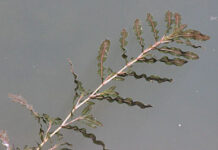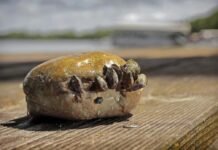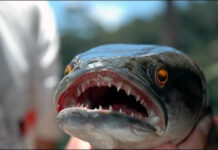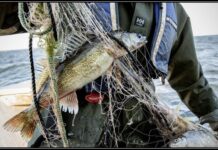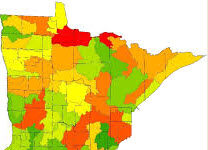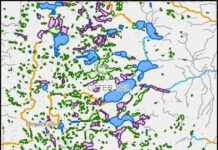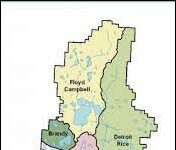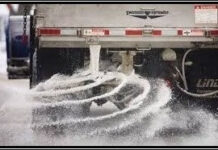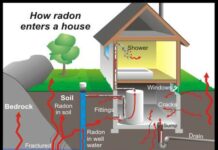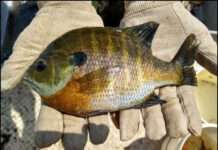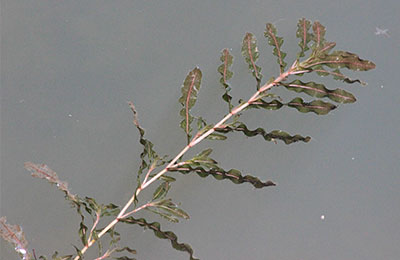Curly-leaf pondweed is a hardy perennial submersed aquatic plant. Attached to the lake or pond bottom by rhizomes, it can grow to reach the lake surface by midspring (Fig. 1). It has a very distinctive appearance with crinkled leaves and finely toothed edges that alternate along the lighter colored and flattened stem (Fig. 2). The oblong, light to dark green leaves are wavy resembling lasagna noodles up to 7½ cm (3 in) long. In spring, curly-leaf pondweed can produce flower spikes that rise above the surface. The small flowers are arranged in a dense terminal spike on a curved 1–2 cm (1/3–3/4 in) stalk, however the main methods of spreading are not by seed, but by asexual stem growth from the perennial rhizomes and reproduction by vegetative structures called turions. Turions are dormant buds that develop in leaf axils (the “joint ” or space where the leaf stem and the stalk of the plant come together), or are present at the tip of short branches (DiTomaso, et al. 2013). They are made up of several overlapping modified leaves resembling small greenish-brown pinecones, and are produced in great numbers by the start of summer.
Curly-leaf pondweed prefers cooler, nutrient rich, alkaline waters. It can grow in depths up to 4.5 m (15 ft), but also occurs in shallow beds in 30–60 cm (1–2 ft) of water. Curly-leaf pondweed has the competitive edge over many native plants as it tolerates low light conditions found during algal blooms and in the winter, even under lake ice.
While most aquatic plants start their yearly growth cycle in the early to mid-spring and reach their maximum growth by late summer, Curly-leaf pond weed evades competition with other aquatic plants by adopting an alternate time frame (Madsen, 2007). Curlyleaf pondweed will begin its new year’s growth in the late summer when turions start sprouting and rhizomes produce new stalks. It’s adapted to cold water and has been found actively growing under 50 cm (20 in) of ice and snow when other plants are dormant (IDNR, 2009). Curly-leaf pondweed grows better in cold water than any other aquatic plant (Madsen, 2007), so the plants may continue to grow slowly throughout the winter. This gives curly-leaf pondweed an early spring growth advantage over other aquatic plant species. Plants reach their greatest growth in late spring, and then begin to breakdown and disappear in early summer. Plant stalks disappear by mid-July after flowering and dropping seed. The main reproductive means is through the production of hundreds of turions in early summer just before the plant dies off (senescence) for the summer. As the plants start decomposing, the turions fall to the sediment where they remain dormant until cooling water temperature triggers their germination in the late summer to early fall. Turions have a very high germination rate of 60–80% and can remain viable in the sediment for several years.
Distribution
This aquatic invasive species is native to Eurasia, Africa and Australia. It was first introduced into the United States in the 1800’s (Robinson, 2002) and is now reported in all the contiguous 48 states except Maine and South Carolina. It is also common throughout southern Canada, Central America and South America.
Impacts to the Aquatic Ecosystem
Curly-leaf pondweed does have value to lakes and ponds by growing through the cooler times of the year when most plants are absent. This provides a source of food and habitat during these times for fish and wildlife (Swistock, 2008). However, this is a very invasive plant that tends to crowd out native submerged plants, reducing biodiversity, and can force wildlife to relocate or perish. It can grow to nuisance levels creating mats that interfere with aquatic, recreational and fishing activities. When curly-leaf pondweed dies back in the summer, the dense mats decay releasing nutrients into the water column which contribute to algal blooms. The decomposing plant material can also deplete oxygen levels in the water, causing anoxic conditions leading to possible fish kills.
Prevention and Control
Protecting water quality can help control overabundant aquatic plants and is best accomplished by limiting, reducing or redirecting the input of external nutrients (primarily nitrogen and phosphorous) into waterways. Potential nutrient sources include runoff from lawns and golf courses, barnyards, fertilized fields, waste from livestock, pets and wildlife, and poorly functioning septic systems. Reductions can be achieved by planting low maintenance lawns, applying less fertilizer near waterways, using phosphorous free fertilizer, maintaining vegetated riparian buffers to absorb nutrients, increasing bank stability to reduce soil erosion, and maintaining proper aeration and good water flow. Not addressing the nutrient issues will lead to a perpetual need to control plant growth. The two challenges of curly-leaf pondweed control include minimizing damage to native plants and to produce a long term control. The key to control is the reduction or removal of turions to interrupt the curly-leaf pondweed life cycle.
To help stop the spread of aquatic invasive plants including curly-leaf pondweed, some steps to be followed include:
- Remove all plant fragments from the boat, propeller and boat trailer to prevent introduction into new lakes and rivers.
- Rinse mud and debris from equipment and wading gear and drain all water from boat before leaving access area.
- Allow all equipment to dry for at least five days before transporting it to a new water body.
- Do not release aquarium, or water garden plants into the wild; seal them in a plastic bag and dispose in trash.
Mechanical
Mechanical removal can help to manage curly-leaf pondweed by reducing biomass, but harvesting methods are not species specific. Hand pulling is a more selective method but is very time consuming and labor intensive. Early season removal using weed harvesters, raking and hand cutting is best done in spring before seeds appear above the water. Plants should be removed as close to the sediment as possible to reduce turion production. All fragments need to be removed from the body of water to be effective. Harvested plants should be disposed of away from the water’s edge so wind or runoff cannot transport the seeds, plants, or turions back into the water body. Other physical controls include bottom barriers preventing growth, and fall/winter lake water level lowering to expose rhizomes and turions to freezing temperatures and desiccation (Madsen, 2007). Physical control can be very effective on small ponds, along with reducing nutrients.
Biological
Triploid sterile Grass Carp (White Amur) are herbivores that will consume and control curly-leaf pondweed as it is a preferred food. In New Jersey, these fish may be purchased from a State approved hatchery after applying for/and receiving the appropriate state permits. Contact: New Jersey Division of Fish and Wildlife, Bureau of Freshwater Fisheries: state.nj.us/dep/fgw/fishperms.htm#stocking.
Chemical Control
- The nuisance plant must be properly identified. Most herbicides control only certain plants and types as indicated on the product label. You should contact a certified herbicide applicator to determine the appropriate method.
- Consider the use of the waterway to be treated. Most herbicides restrict the use of the water until the herbicide has been degraded, inactivated or dissipated.
- New Jersey DEP administers the regulations regarding application of chemicals to waterways in New Jersey. Applications require a permit and certified applicator.
- Calculation of water area/volume to be treated is needed for proper dosage.
- Method of application may affect choice if a certain type of equipment is needed for treatment to be effective.
- Timing is important when deciding which herbicide to use. For curly-leaf pondweed it is best to treat in late winter or early spring when the plants are actively growing, but before they create a dense mass. This will reduce the amount of algae needed to be killed and reduce the chance of fish kills due to low dissolved oxygen caused by decaying plants.
- Temperature affects the efficacy of some herbicides. Application should be when plants are actively growing with a compatible temperature. Label recommendations should be followed.
March and April treatments using contact herbicides with active ingredients of diquat or endothall have shown positive effects in reducing curly-leaf pondweed biomass as well as suppressing turion production (Poovey, et al., 2002). Whole pond treatments with fluridone, a systemic herbicide can also be used. Potential problems in controlling curly-leaf pondweed include a lag time between initial treatment and plant die-off, regrowth the following year and removal of beneficial native plants. Because the turions are extremely hardy and can lie dormant for years, control is often necessary every year or multiple times a year.
References and Resources
- (APIS) Aquatic Plant Management Information System. 2012. U.S. Army Corp of Engineers, Engineer Research and Development Center. Potamogeton crispus L. (Curly-leaf Pondweed). el.erdc.usace.army.mil/apis/PlantInfo/plantinfo.aspx?plantid=49.
- Bormans, S. 1995. Curly-leaf Pondweed. University of Wisconsin Extension. Lake tides 20(1) pp. 5–6
- DiTomaso, J.M., G.B. Kayser et al. 2013 Weed Control in Natural Areas in the Western United States. Weed Research and Information Center, University of California. 544pp.
- Hart, Steven A. 2001. Aquatic Weed Control. Rutgers Cooperative Extension, Fact Sheet, FS386. New Brunswick, NJ. njaes.rutgers.edu/pubs/publication.php?pid=FS386.
- (IDNR) Indiana Department of Natural Resources, Aquatic Invasive Species – Plants. 2009. Curly-leaf pondweed. in.gov/dnr/files/CURLYLEAF_PONDWEED.pdf (PDF).
- Madsen, J. D. 2007. Curly-leaf Pondweed (Potamogeton crispus L.) Description, Distribution and Management. Mississippi State University, GRI Publication 5021. gri.msstate.edu/research/invspec/factsheets/4P/Curlyleaf_pondweed.pdf (PDF).
- Poovey, A. G., J. G. Skogerboe and C. S. Owens. 2002. “Spring Treatments of Diquat and Endothall for Curly-leaf Pondweed Control”. Journal of Aquatic Plant Management 40: 63–67. apms.org/japm/vol40/v40p63.pdf (PDF).
- Swistock, B.A. 2008. Curly-leaf Pondweed. Pond Facts # 17. Penn State University Cooperative Extension. School of Forest Resources. pubs.cas.psu.edu/FreePubs/pdfs/XH0025.pdf (PDF).
- Stop Aquatic Hitchhikers! website. Aquatic Nuisance Species (ANS) Task Force, U.S Fish & Wildlife Service and U.S. Coast Guard. protectyourwaters.net/prevention.
- Rizzo, D., S. Boser, and B. Swistock. 2009. A Field Guide to Common Aquatic Plants of Pennsylvania. Ag Communications and Marketing, Penn State College of Agricultural Science. 105pp. pubs.cas.psu.edu/FreePubs/pdfs/agrs110.pdf (PDF).
- Robinson, M. 2002. Curly-leaved Pondweed: An Invasive Aquatic Plant (Potamogeton crispus). Massachusetts Department of Conservation and Recreation, Office of Water Resources, Lakes and Ponds Program. mass.gov/eea/docs/dcr/watersupply/lakepond/factsheet/curly-leaved-pondweed.pdf (PDF).
- University of Florida Center for Aquatic and Invasive Plants. 2013. Curly pondweed. plants.ifas.ufl.edu/node/338.

